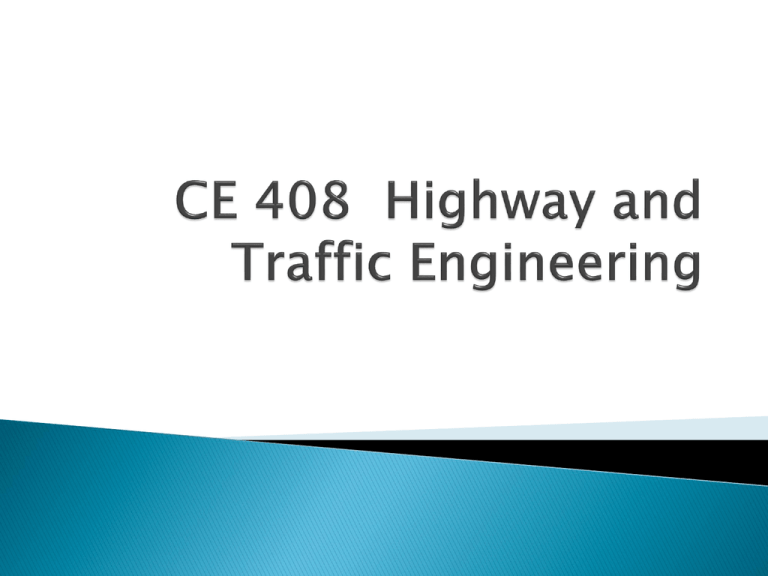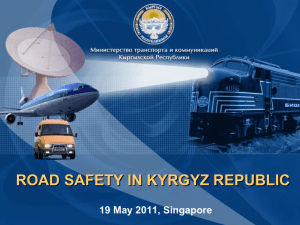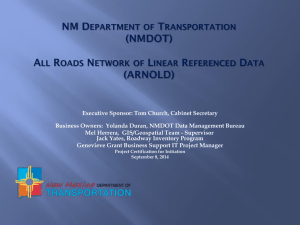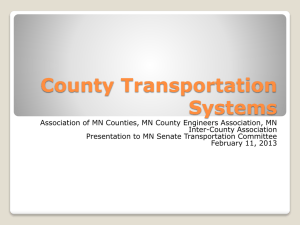LEC - 01 - wec civilians
advertisement

Transportation is a way of moving people or things from one place to another. Land (roads and railways) Water(seaports) Air(airports) Highway engineering is an engineering discipline branching from civil engineering that involves the planning, design, construction, operation, and maintenance of roads, bridges, and tunnels to ensure safe and effective transportation of people and goods Traffic engineering is a branch of civil engineering that uses engineering techniques to achieve the safe and efficient movement of people and goods on roadways. It focuses mainly on research for safe and efficient traffic flow, such as road geometry, sidewalks and crosswalks, segregated cycle facilities, shared lane marking, traffic signs, road surface markings and traffic lights. Traffic engineering deals with the functional part of transportation system, except the infrastructures provided. There are three main elements of automobile transportation: The road users (Drivers and pedestrians) The vehicle The road way and geometric design of roads Depending on weather • All weather roads • Fair weather roads Depending the type of Carriage way National highway act ( 1956 • Paved roads ) • Unpaved roads Depending upon the pavement surface • Surfaced roads • Un surfaced roads Based on the Traffic Volume Heavy Medium Light Primary Expressways National Highways Secondary State Highway Major District Roads Tertiary Ordinary district Roads Village Roads Heavy traffic at high speed (120km/hr) Land Width (90m) Connects major points of traffic generation No slow moving traffic allowed No loading, unloading, parking. The National Highways of Pakistan consists of all public highways maintained by National Highways Authority under the Ministry of Transport. It maintains over 12,000 kilometres (7,500 mi) of roadways organised into various classifications which crisscross the country and provide access to major population centres.. All national highways in Pakistan are pre-fixed with the letter 'N' (for "National") followed by the unique numerical designation of the specific highway (with a hyphen in the middle), e.g. "N-5". Each numerical designation is separated by five numerals, i.e. N-5, N-10, N-15, etc. They are the arterial roads of a state, connecting up with the national highways of adjacent states, district head quarters and important cities within the state. Important roads with in a district serving areas of production and markets , connecting those with each other or with the major highways. Roads serving rural areas of production and providing them with outlet to market centers or other important roads like MDR or SH. They are roads connecting villages or group of villages with each other or to the nearest road of a higher category like ODR or MDR. ARTERIAL ROADS SUB ARTERIAL COLLECTOR LOCAL STREET PATHWAY DRIVEWAY All roads arterials principle Full control interstates Freeways/expresways Non arterials minor uncontrolled local collector major minor Arterials primarily serve long-distance travel and are typically designed as either access controlled or partially access controlled facilities with limited locations at which vehicles can enter or exit the roadway (typically via on- or off-ramps). Design Speed : 80km/hr Land width : 50 – 60m Divided roads with full or partial parking Pedestrian allowed to walk only at intersection Less mobility than arterial. Design speed : 60 km/hr Land width : 30 – 40 m As their name implies, Collectors “collect” traffic from Local Roads and connect traffic to Arterial roadways. Collector routes are typically shorter than Arterial routes but longer than Local Roads. (Collects and distributes traffic from local streets Provides access to arterial roads Located in residential, business and industrial areas. Full access allowed. Parking permitted. Design speed : 50km/hr Land Width : 20-30m Design Speed : 30km/hr. Land Width : 10 – 20m. Primary access to residence, business or other abutting property Less volume of traffic at slow speed Origin and termination of trips. Unrestricted parking, pedestrian movements. (with frontage access, parked vehicle, bus stops and no waiting restrictions) Engineering Surveys for Highway locations 1) Provisional alignment Identification ( Map study) 2) Reconnaissance survey 3) Preliminary survey 4) Final location to determine center line and detailed survey Art of observing and making measurements of relative portions of natural and manmade features on the surface of earth and plotting these measurements to some suitable scale to form a map. Highway surveys involve measurement and calculation of distances, angles (horizontal and vertical) and elevations. The data is then used to form a base map with contour lines and longitudinal crosssections. Three major categories 1. Ground Surveys Basic equipment is used for location survey Measuring Tape. Levels. Theodolite. Electronic distance measuring devices (EDM’s). 2. Remote Sensing Measurement of distances and elevations by using devices located above the surface of earth. Data is collected through airplanes and satellites using global positioning systems (GPS). Photogrammetry (data is obtained with the help of aerial photographs) is the most commonly used technique. 3. Computer Graphics Available/collected data is compiled and stored in the electronic form. Photogrammetric and general survey data is combined digitally with the help of softwares. The files can then be plotted in the form of maps. Location controls are basically the factors that effects the selection of location of a highway Major factors are: Topography. Soil Characteristics. Environmental factors (noise and air pollution). Economic factors. Highway location process have four phases Desk study of available data/information Reconnaissance survey Preliminary location survey Final location survey Available data in the form of reports, maps,aerial photographs and charts is studied. Data is obtained form government authorities e.g. transport department (NHA), geological survey of Pakistan etc. Similarly, information is required to be obtained on hydrology, mining, agriculture and weather. Data is obtained on the following characteristics: Engineering (topography, geology, traffic volume and climate) Social (land use trends and zoning) Environmental (air, noise and water pollution, wildlife, historic and archaeological sites) Economic (construction cost, agricultural, commercial and industrial trends) “Reconnaissance is the process of identifying several possible routes & evaluating the feasibility of these routes for a highway between specific points” Aerial photographs are often used for the purpose, especially for rural areas. Feasible routes are identifies by keeping in mind the following factors Terrain and soil conditions. Serviceability of route to industrial and residential areas. Crossing of other transportation facilities like rivers, rail and highways. Route directness. Identification of control points for each feasible/selected route. Routes are then plotted on a map. The position of the feasible routes are set as closely as possible by Establishing all control points. Determining preliminary vertical and horizontal alignments of each control point Economic and environmental feasibility of the routes The best route is then selected as the preliminary alignment for the highway. Initial cost of the project and future economic effects Road user cost Construction cost Road user benefits Economic drawbacks from the project Information also helps in deciding the type of highway for a particular route. Environment Includes plant animals Human community Effects on quality of life for all (animals and human being) An environmental impact statement should be submitted which should include Available alternatives Assessment of all positive and negative impacts Short and long term effects Unavoidable adverse environmental effects Use of natural resources Each route should be studied e.g. Positive and negative effects of at grade or grade seperated intersection. Detailed layout of the selected route is carried out at this stage Centreline of the road. Horizontal and vertical alignment. Property lines. Intersecting roads. Position of structures and drainage channels. Transferring the alignment on to ground. Detail Survey – levelling work for longitudinal and transverse direction. Intervals for cross sectional levelling Plain 50 – 100m Rolling 50 – 75m Built up 50m Hilly 20m Soil Profile Factors that effect location of highway in urban areas Connection to local streets (which street to connect,traffic flow) Right-of-way acquisition (land cost, road on elevated structures, noise and aesthetics) Coordination with other transportation systems Provisions for bicycles and pedestrians (sidewalks,crosswalks, traffic control devices, ramps, bicycle path) Elements of comparison Conventional Modern Maps- Base material Topo sheets RS data, Aerial Photos, Satellite Imageries Instruments Chains, Tapes, Theodolite, Dumpy levels EDM, Total Station, GPS, Auto and Digital Level, Photogrammetry. Accuracy Chain/Tape 1 in 3000 to 1 in 30,000 Tacheometer 1 in 1000 to 1 in 10,000 EDM/TS 1 in 10000 to 1 in 1,00,000 Photogrammetry. 1 in 10000 to 1 in 1,00,000 Plotting CAD Systems Software Errors Human errors Closing Errors hence re measuring is required.








